![]()
![]()
![]()
Use LEFT and RIGHT arrow keys to navigate between flashcards;
Use UP and DOWN arrow keys to flip the card;
H to show hint;
A reads text to speech;
25 Cards in this Set
- Front
- Back
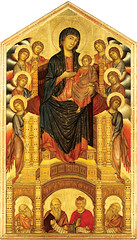
"Madonna Enthroned with Angels and Prophets" Cimabue (1280-90) tempera on wood |
• gold background • creates deeper space for Madonna with curved bottom edge of throne • hierarchy of scale (angels smaller than Mary) |
|
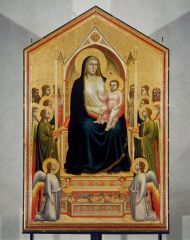
"Madonna Enthroned" Giotto (1310) tempera on wood |
• More defined body than Cimabue's Mary (portrayal of virgin as human) • Angles stacked on common level • traditional gold background remains |
|
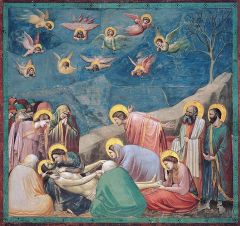
"Lamentation" Giotto (1305-06) fresco |
• Portrays Passion of Christ • interest of portraying biblical na • Angels are foreshortened • orthogonals of people's heads and landscape lead eye towards Mary and Jesus |
|
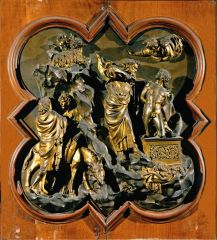
"Sacrifice of Isaac" Lorenzo Ghilberti (1401-02) gilded bronze relief |
• winner of the Baptistry Doors competition • won because used less bronze (cheaper to produce) and portrayed more modern style • quatrefoil frame • foreshortening of angel |
|
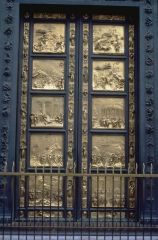
"Gates of Paradise" (east doors of Florence Baptistry) Lorenzo Ghilberti (1425-52) gilded bronze relief |
• panels use continuous narrative • linear perspective |
|
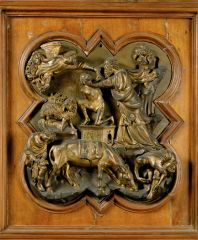
"Sacrifice of Isaac" Filippo Brunelleschi (1401-02) gilded bronze relief |
• Runner-up for Florence Baptistry Doors competition |
|
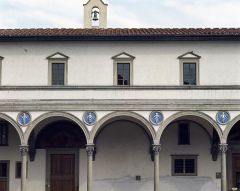
Facade, Ospedale degli Innocenti (Foundling Hospital) Filippo Brunelleschi (1419-24) |
• Methodical, rational architecture • featuring colonnades and arcades |
|
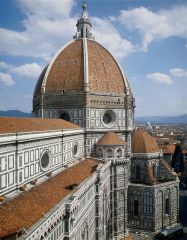
Dome, Florence Cathedral (Santa Maria del Fiore) Filippo Brunelleschi (1420-36) |
• first large-scale, self-supporting dome to be constructed without flying buttresses • animal-powered hoists invented to construct dome |
|

Palazzo Medici-Riccardi Michelozzo di Bartolommeo ( 1444-48) |
• floors show gradient of texture - ground floor = heavy rustication - 2nd floor = dressed masonry - 3rd floor = smoother masonry - cornice all around top of building reverses gradient effect • seen as plain style architecture at time of construction |
|

"David" Donatello (1440-60) bronze |
• contrapposto • commissioned by Medici fam to signify Medici has more power than Florence authorities • David appears as young boy • |
|
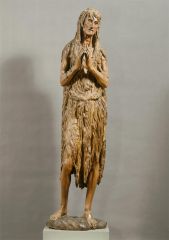
"Mary Magdalen" Donatello (1455) polychromy and gilt on wood |
• Mary portrayed as old, poor woman (typically portrayed as young and beautiful at the time) • sculptor chose to use wood even though wood warps with time and is a difficult material to work with • carved to be viewed from all angles |
|
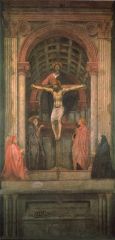
"The Holy Trinity" Masaccio (1424-27) fresco |
• features donor portraits • linear perspective • portrays father (God), son (Jesus), and Holy Ghost (seen as a dove) • Virgin Mary and John the Evangelist @ base of cross • skeleton @ bottom = reminder of death |
|
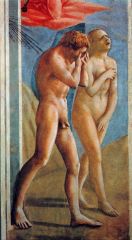
"Expulsion of Adam and Eve from the Garden of Eden" Masaccio (1424-27) fresco |
• based on Genesis of Old Testament • study of muscles (artists analyzed dead bodies before models became widely available) = shows growing interest in depicting human body (especially nudes) with more emotion than previously painted |
|
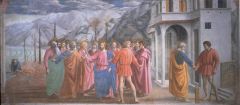
"The Tribute Money" Masaccio (1424-27) fresco |
• continuous narrative, scenes separated w/ negative space • painting based on New Testament (Jesus tells Peter to collect money from fish in river to give to tax collector) |
|
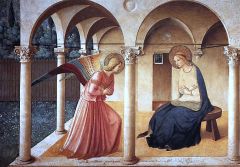
"Annunciation" Fra Angelico (1440-45) fresco |
• depicts Annunciation • linear perspective w/orthogonals created by portico • Mary sits within portico; Gabriel stepping in from outside • arcades and colonnades |
|
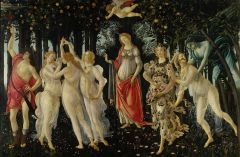
"Primavera" Sandro Botticelli (1482) tempera on panel |
• commissioned by Medici family as wedding gift • represents 2 options for love: love and desire = violence, OR love + faith = approval of God |
|

"Portrait of an Old Man with his Grandson" Domenico Ghirlandaio (1490) tempera on wood |
• 3/4 turn • faces are more specific = humanism |
|
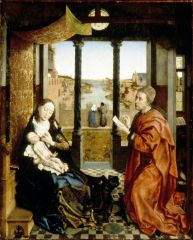
"St. Luke Drawing the Virgin" Rogier van der Weyden (1435-40) oil and tempera on panel |
• artist draws himself as St. Luke (rising status of artist) • St. Luke depicted drawing, usually seen painting • Mary and St. Luke seen as equally important • high detail possible b/c intro of oil paint • background descriptive of Euro. landscape • St. Luke identifiable by ox on right side |
|
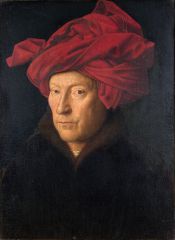
"Man in a Red Turban" Jan van Eyck (1433) oil on panel |
• high detail possible b/c into of oil paint • potential self portrait, NOT portrait of artist as another figure (rising status of artist) • first known western portrait in 1000 yrs where subject looks DIRECTLY at viewer • shows personal motto "Als Ich Can" (As I Can) |
|
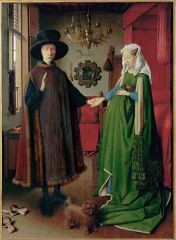
"Giovanni Arnolfini and His Bride" Jan van Eyck (1434) oil on wood |
• LOTS of iconography (dog = loyalty, peaches = Medici power, candle burning in daylight = presence of God, etc.) |
|
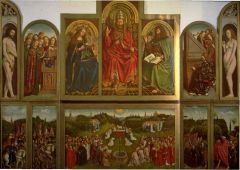
"Ghent Altarpiece" Jan van Eyck (1432) oil on panel |
• donor portrait • polyptych • shows annunciation on closed view and salvation of humanity on open view • Adam and Eve are less idealized, more human • high detail possible b/c into of oil paint |
|
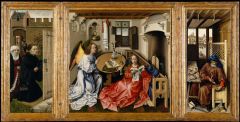
"Merode Altarpiece" Robert Campin (1425-28) oil on wood |
• triptych • donor portraits on left panel • iconography (fire screen = protection of Mary, white lilies = purity, etc.) • appears in domestic setting to establish Mary as a part of home • linear perspective • portrays Annunciation |
|
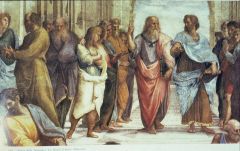
"Philosophy" (School of Athens) Raphael (1509-11) fresco |
• "in situ" - commissioned by Pope to communicate that catholicism is well-grounded/educated • naturalistic detail and intricate depiction of reality • portrays Plato (left) and Aristotle (right) and other scientists/philosophers in specific groups based on discipline w/ Raphael on right side |
|
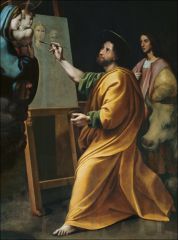
"St. Luke Painting the Virgin" Raphael (1511-20) oil on canvas |
• St. Luke appears more prominent than Mary and Jesus • painting within painting • Mary appears as divine figure from cloud • St Luke identifiable by ox • Nondescript background |
|

"Self Portrait" Leonardo da Vinci (1512) red chalk on paper |
• rising status of artist |

